Television: Past (September 7, 1927 - March 2012)
Television Present Television Home Television Future
In this day and age, it is hard to imagine our lives without the television industry. For our generation in particular, the television industry has existed for as long as we can remember. Television has simply always been there for us. This makes it difficult for us to picture a world before television, and yet such a world did in fact exist. Today we'll take a look at the origins of television and how it progressed to the modern age.
How did this industry move from a new technology to the mass media business that is here today?
Television overtakes radio.
Radio sets the stage for Television: The Radio Industry assisted greatly in the early business models of the television industry. In fact two of the future big networks for television began as radio networks. NBC as well as CBS started off as radio networks during the 1920s. Television essentially copied the same business model of radio. They began with covering news events as they unfolded much like radio but with the key advantage of have access to picture of said events they slowly but surely began to take radio's news covering. As time went on they began to air television shows that had defined narratives to tell. These works took away from similar radio detective shows, comedies, and more. [1]
NBC splits and the Rise of Television: NBC during the time of the rise of television had two national radio networks that in worked out of. One of the NBC radio networks was referred to as the Red Network and was the more renowned network of the two. While the other NBC radio network was known as the lower profile Blue Network. Each of these networks as well as CBS beginning to delve into the possibilities that television offered in the 1930s. Eventually the two NBC networks would separate into two different television broadcasting networks. ABC began as of 1943 when the Blue Network of NBC was deemed as anticompetitive for NBC's business model. This resulted in the three separate television broadcasting networks that would later come to be known as the Big Three. Though they would start small with only a few television broadcasting stations each, they would come into their own and become a mass media powerhouse that could operate nationwide by the 1950s. In fact network television would become so popular that it would come to even outsell radio with more television set sales than radio receivers by 1951. [1]
Further impacts of the Television industry on other industries can be seen later with the film industry under television technologies.
What were the major plot twists of this industry?
What were key technological advancements? Who were the original people/organizations involved? How did the innovations help/hurt the growth of the industry?
Zworykin 
Born in July 30, 1889 and died in July 29, 1982. Vladimir Zworykin was an important inventor in the 20th century. He created the iconoscope, which was the first practical, all electronic television camera tube. Later in the 1929, he invented the important part of the receiver called the kinescope or cathode ray tube. From his works, television had moved from mechanical television to electronic television. Zworykin was born in Russia. When he was a young engineering student, he worked for physicist Boris Rosing who was trying to send pictures through the air. Zworykin moved to the USA in 1919 following the Russia Revolution. He worked at the Westinghouse and later moved to Radio Corporation of America where he made his electronic inventions: iconoscope and kinescope. [2] [3]
The inventions of Zworykin moved the mechanical television systems to the electronic television systems. His inventions had a big impact on the revolution of television. Despite his lost to Philo Farnsworth, Zworykin’s designs for electronic television would not be consider the first. Some people still considered him as "Father of Television." He was an important person to the TV industry. His contributions were immense to the television industry's technological advancement. [2] [4]
Farnsworth
[5]

Philo Farnsworth, born on August 19, 1906 and died on March 11, 1971, was the man credited for creating the electronic television. It was in 1927 that "Philo was the first inventor to transmit a television image comprised of 60 horizontal lines. The image transmitted was a dollar sign. Farnsworth developed the dissector tube, the basis of all current electronic televisions. He filed for his first television patent in 1927. Although he won an early patent for his image dissection tube, he lost later patent battles to RCA. Philo Farnsworth went on to invent over 165 different devices including equipment for converting an optical image into an electrical signal, amplifier, cathode-ray, vacuum tubes, electrical scanners, electron multipliers and photoelectric materials." [2] [6] [7]
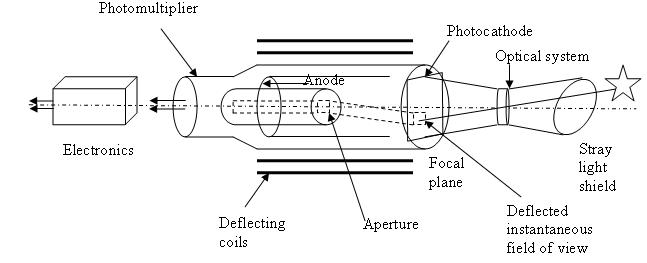
National Television Systems Committee (NTSC)
In the late 1930s, the National Television Systems Committee (NTSC), and group representing major electronics firms, began outlining industry-wide manufacturing practices and compromising on technical standards. They are responsible for bringing about video standards. [2]

Analog Standards
- 1941: The Federal Communications Commission (FCC) adopted an analog standard (based on radio waves) for all U.S. TV sets.
- 1940s: FCC began assigning channels in specific geographic areas to make sure there was no interference.
- 1948: FCC had issued nearly 100 TV licenses, and there was a growing concern about the finite number of channels and the frequency-inference problems so FCC declares freeze. Only 1% of America’s households have a TV.
- 1951: TV set sales surpasses radio receiver sales.
- 1952: NTSC conference sorts out technical problems, FCC ends freeze, and almost 1,300 communities received TV channel allocations. [2] [8]
To understand what exactly the analog standard is, first we must understand what analog transmission are and how they fit into this. An analog transmission is basically the broadcasting of audio and visual footage. So in simple terms the quality of the transmission can vary from poor, high definition and so on, based on how well it is broadcast. This gave rise to what was known as the Analog Standards. The Analog Standards were made as a guide for television industries to follow. In simple terms the analog had to meet a certain demand of quality to meet said standards. The Analog Standards for television were not put into place until 1941 by the Federal Communications Community or FCC for short. Over time the FCC began adopting the Analog standard, based on radio waves, for all the United States television sets. With the standards the United States had set for analog other countries soon began to follow suit. More than 30 other countries across the globe had also adopted the analog standard. The only major areas that did not adopt this standard was the majority of Europe as well as most of Asia due to the fact that they followed a different analog standard. [2]
Not long before the Analog standard was put in place, during the 1940's the FCC had began to assign channels in specific geographical areas to make sure there was no real interference. At the time, there was very limited amounts of television broadcasting stations due to the airwave frequencies. Back then, the airwave frequencies could only be broadcast in a small number of signals at a time or they would run into performance issues. This meant that the larger the population of an area the more television stations were made and dedicated to that area. In simpler terms the larger the city, the more television stations they had. Unfortunately for smaller cities, this meant that very little to no broadcast stations were dedicated to them. [2]

Later in 1948, as the FCC had continued their work, they had come to the point where they had issued nearly 100 television licenses. This fact began to raise concerns about the finite number of channels and frequency-interference problems. As a result the FCC decided to declare a freeze on new television licenses. The total duration of this freeze would not be resolved until 1952. During this same time period television, though only owned by 1% of Americans in 1948, the television industry began to have some ripple effects on the other industries. These ripple effects included a rise in theater sales in cities without television. Due to the lack of television, these city goes relied on the theater to provide their electronic entertainment. Despite the rise in sales for theaters in these cities, the opposite result occurred in cities with television. With the acess of electronic screen entertainment in the comfort of their own homes, the turn out for movie goers in these cities declined. Television continued to increase in popularity to such an extent that by 1951 the sales of the electron television set had overtaken the sales of the previous source of electronic home entertainment: radio receivers. Television had begun to make such an impact that nightclub attendance as well as taxi cab usage numbers went down. Finally after a few years, the NTSC was able to sort out all of the technical problems with the television channel frequencies in 1952. As a result the FCC ended the four year long television license freeze and nearly 1,300 communities were able to receive TV channel allocations. It could be plainly seen by the mid-1950s that television had made its mark on mainstream society and become a mass medium. [2] [9]
Color Television
- 1952: FCC tentatively approves an experimental CBS color system, but the system was incompatible with black and white TV sets.
- 1953: More than 50% of America’s households have a TV.
- 1954: RCA’s color system which sent TV images in color, but also allowed older sets to view them in black and white. NBC starts broadcasting a few shows in color.
- 1960s: More than 90% of all homes have TV.
- 1966: the big three networks (CBS, NBC, and ABC) broadcast their entire evening lineups in color. [2]
Before the innovation of the color television, every television set came in black and white picture. This trend continued until 1952, at which time the FCC approved a experimental color system funded by one of the big three networks CBS. Unfortunately for CBS the color system they had developed ended up being incompatible with the common black and white television sets that most american families owned. It wasn't until 1954 that the next first success in colored television took place. The RCA had created their own color system that easily trumped CBS's due to said system's ability to send colored images as black and white as well as colored. This resulted in the RCA's color system becoming the color standard. [2]
CATV-Community Antenna Television
- The first small cable system originated in Oregon, Pennsylvania, and New York City, where mountains or tall buildings blocked TV signals.
- The invention of CATV is credited to John Walson.
- Served 10% of the country
- Contained only 12 channels and relied on wires
- There were 2 big advantages to CATV:
(1) By routing and re-amplifying each channel in a separate wire, cable eliminated over-the-air interference
(2) Running signals through coaxial cable increased channel capacity. [2]
The first small able television was originally known as community antenna television (CATV). The CATV began in 1948 with its creation being credited to John Walson. After feeding a cable from his appliance store and the homes of certain customers, to an antenna on he placed on a mountain top, Walson managed to create this CATV system. While CATV would not become well known until the 1970s due to FCC regulations, it would eventually service 10% of the United States with its limited 12 channels. [2]
Cable 
The Wires and Satellites behind Cable Television 
- 1945: Arthur C. Clarke published the original theories for a global communications system based on three satellites equally spaced from one another rotating with the Earth’s orbit.
- Mid 1950s: Soviet Union and then the United States successfully sent satellites into orbit around Earth.
- 1960: AT&T launched Telstar, the first communication satellite capable of receiving, amplifying, and returning signals.
- Mid 1960s: Scientists figure out how to lock communications satellites into geosynchronous orbit – hovering 22,300 miles above Earth, satellites travel nearly 7,000 MPH and circle Earth at the same speed Earth revolves around its axis.
- 1972: Canada’s Anik domestic communication satellite launches
- 1974: US’ Westar domestic communication satellite launches
- Headend: a computerized nerve center where cable TV signals are processed, which operates various large satellite dishes that receive and distribute long-distance signals as well as an area’s local signals.
- Trunk and Feeder Cables: How Headend computers relay channels; attached to existing utility poles.
- Drop or Tap Lines: Run from utility poles into subscribers’ homes.
- 1970s: Advances in satellite technology dramatically change fortune of cable by creating a reliable system for the distribution of programming to cable companies across the nation.
- 1975: First cable network to use satellites for regular transmission of TV programming was Home Box Office (HBO), which began delivering programming such as uncut, commercial-free movies and exclusive live coverage of boxing for a monthly fee.
- 1976: Second cable network began when media owner Ted Turner distributed his small Atlanta broadcast TV station, WTBS to cable across the country. [2] [10] [11]
Cable Services 
(1) Basic Cable: In cable programming, a tier of channels composed of local broadcast signals, non-broadcast access channels (for local, government, education, and general public use), a few regional PBS stations, and a variety of cable channels downlinked from communication satellites.
(2) Superstations: local independent TV stations, such as WTBS in Atlanta or WGN in Chicago, that have uplinked their signal onto a communication satellite to make themselves available nationwide.
(1) Premium Channels: in cable programming, a tier of channels that subscribers can order at an additional monthly fee over their basic cable service; these may include movie channels and interactive services.
(2) Pay-per-view (PPV): a cable-television service that allows customers to select a particular movie for a fee, or to pay $25 or $40 for a special one-time event.
(3) Video-on-demand (VOD): cable television technology that enables viewers to instantly order programming such as movies to be digitally delivered to their sets. [2] [12]
Satellite
Cable without Wires: Direct Broadcast Satellite (DBS): In 1999 DBS appeared on the scene. This was a satellite-based service that for a monthly fee downlinks hundreds of satellite channels and services; DBS began distributing video and programming directly to households in 1994. As a result, satellite TV became something of a competitor with cable due their claim of offering the same quality content for less. [2] [13] [14]


Home Video
VCR 
- 1975-76: VCRs (videocassette recorders) enabled viewers to tape-record TV programs and play them back later.
- Marketing War: Sony Betamax Vs. JVC’s VHS (video home system). For
- Video Recording Court case Disney and MCA vs Sony: After the invention of home video recording, Disney as well as MCA (Music Corporation of America) attempted to sue Sony in 1976, claiming that they were in violation of copyright laws by allowing owners of these VCR recorders to copy their content onto other sources.
- 1979: Sony won the federal court case. The ruling permitted home taping for personal use. This ruling would later result in video rental stores.
- 1980s: video rental stores come into being and gain popularity in response to the Disney and MCA vs Sony case. During this time the Sony caves and begins developing VHS as well abandoning the VCR model. [2] [15]
DVDs Replace VHS
- DVD's: Digital Video Disk or DVD reached popularity in 1995 due to the digital format giving higher quality video as well as more storage space than the VHS. DVD slowly overtakes VHS over the next few years.
- 2007: Marketing war: HD DVDs vs. Blu-ray DVDs. For a time there was competition between which format would replace the common DVD. HD DVD's as well as Blu-ray disks both promised higher quality picture. Though both of them used similar blue-violet laser technology the Blu-ray's was superior in several respects. Some companies backed the Blu-ray disc, some companies, particularly Toshiba, backed HD DVD's. Despite their best efforts Toshiba would eventually cave in 2008 to the superior technology of the Blu-ray disc format. [2]
DVRs
- 2012: DVRs (digital video recorders) are in more than 50% of homes [2]
Close Captioning
- Close Capturing first appeared during the 1970's. This innovation was brought about in order to accommodate individuals who suffered from hearing problems including the deaf and those that required hearing aids. It was also a tool to be utilized for those who were not familiar with or speak the English language well. This allowed for people to understand what individuals were saying in a text format on the bottom of the screen. Eventually by 1993, the addition of close captioning became a television requirement for all future television sets.
 [16]
[16]
Digital Signal
- 2009: Analog signals were replaced by digital signals; these translate TV images and sounds using binary codes and allow for increased channel capacity and improved image quality and sound.
- HDTV (High Definition Television): digital signals offer the highest resolution and sharpest image.
Slowly, as technology began to advance, antenna television's analog picture would begin to switch to digital. It was the Netherlands that was the first country to switch to digital signal in 2006. The United States would eventually follow suit and make the change from an analog standard to a digital standard by 2009. Unlike analog, digital TVs did not function through the use of radio waves and instead created images and sounds through the use of binary codes. As such the switch in technology allowed for a much clearer and higher definition signal. Digital signal also allowed for more channels to be accessed. To compensate for those who wished to continue to use older television sets, a digital converter box was integrated as to convert the new signal to be accessible for the older televisions. [2]
High definition television had also become introduced during the 2000s. HDTV allowed viewers access to a much higher standard of television, it also brought about the ability to view television shows on laptops as well as smart cell phones. These came to be known as third and fourth screens. While the HDTVs began in the 1980s they didn't become popular in the United States until the 2000s as before mentioned. The High Definition Televisions are TVs that provided the highest resolution and sharpest image. They have multiple formats in which they can display picture: 1080p, 1080i, 720p (p: progressive scan; i: interlaced) The interface ratio of an HDTV screen is 16:9 as opposed to the standard definition of 4:3 which was an influence brought on by widescreen cinema. [2]
Internet Connected TV Sets 
- 1994: The first patent put in for smart televisions was placed by a French company. Though the idea of smart TV's didn't take off until near 2009-2010.
- Smart Televisions: These innovative electronic creations are the integration of the internet and several online features into a modern television set. These televisions immerse the user with these online features all without the use of a computer.
- Online Features and Advantages: The average smart television has access to plenty of online streaming sources such as Netflix, Hulu and more. In addition they also have access to games like Angry Birds, Social media sites like Facebook, and other applications. Other smart televisions will even has access to web browsing. The extent of the features will vary from television provider due to there not yet being a solidified standard for the smart TV.
- Other Features: Certain other features of the smart television include personalization. Smart TV's can be programmed to remember the users favorite channels and keep favorites list for easy access. [17] [18]
How did/does the business make its money?
 [19]
[19]
The Network Era
Network Era refers to the period of time spanning from the late 1950s to the 1970s when the Big Three broadcast networks known as CBS, NBC, and ABC controlled the vast majority of every trend of television programming. These networks would often accommodate the programs shown depending on the current time period, with their television line ups changing from westerns to sitcoms over the next several decades to adapt to the viewers wants. [2]
Early TV - One Sponsor
Early TV programs where developed, produced, and supported by a single sponsor. Ex/ Buick Circus Hour, Camel News Caravan, and Colgate Comedy Hour. Typically 15 minutes long. With this model the sponsor had complete control over content, which lead to the devastating quiz show scandals. After the scandal it took forty years for a quiz show to return to TV (Who Wants to Be a Millionaire). [2]
Here is an example of an old game show sponsored by one sponsor (Winston), but also interesting to hear and see Farnsworth himself.
[20]
PBS
During the 1960s a Public Broadcasting Station was put into effect by congress through the Corporation of Public Broadcasting and was dubbed as PBS. This channel was created as means to distribute information over television and inform television viewers through a nonprofit and noncommercial network. PBS was made a reality after congress passed the Employing the Public broadcasting Act in 1967. PBS then started broadcasting two short years later in 1969
Move to 30 and 60 Second Ad Slots
- David Sarnoff: Head of RCA/NBC
- William Paley: Head of CBS
- 1953: Sarnoff appoints Sylvester “Pat” Weaver as the president of NBC. Weaver increases program length to 30 minutes or longer, substantially raising program costs for advertisers and discouraging some from sponsoring.
- Magazine Program: featured multiple segments – news, talk, comedy, and music – similar to magazines of the day Life and Time.
- January 1952: NBC introduces the Today show as a three-hour morning talk-news program.
- September 1954: NBC premiered the ninety-minute Late Show.
- NBC offers advertisers spot ads – 30 or 60 second slots; giving networks control of production instead of sponsors.
- In practice, television is an industry in which networks, producers, and distributors target guarantee, and “sell” viewers in blocks to advertisers. [2]
Retransmission Fees
- Retransmission fees: the fee that cable providers pay to broadcast networks for the right to carry their channels.
- 1965 - Must-Carry Rules: Rules established by the FCC requiring all cable operators to assign channels to and carry all local TV broadcasts on their systems, thereby ensuring that local network affiliates, independent stations (those not carrying network programs), and public television channels would benefit from cables clearer reception.
- Basically, cable providers must pay broadcast networks what they provide for free to anyone with an antenna. [2]
Affiliate Stations
Affiliate Station: a radio or TV station that, though independently owned, signs a contract to be part of a network’s programs; in exchange, the network reserves time slots, which it sells to national advertisers. [2]
Syndication
- Even with advertising content may be in deficit until syndication.
- Syndication: Leasing TV stations or cable networks the exclusive rights to air TV shows.
- Each year, executives from thousands of local TV stations and cable firms gather at the National Association of Television Program Executives (NATPE) convention to buy or barter for programs that are up for syndication.
- Evergreens: in TV syndication, popular, lucrative, and enduring network reruns, such as the Andy Griffith Show or I Love Lucy.
- Fringe Time: In television, the time slot either immediately before the evening’s prime time schedule (called early fringe) or immediately following the local evening news or network’s late-night talk shows (called late fringe).
- Types of Syndication
(1) Off-network syndication: In television, the process whereby older programs that no longer run during prime time are made available for reruns to local stations, cable operators, online services, and foreign markets.
(2) First-run syndication: In television, the process whereby new programs are specifically produced for sale in syndication markets rather than for network television.
(1) Cash Deal: the distributor offers a series for syndication to the highest bidder.
(2) Cash-plus deal: distributors retain some time to sell national commercial spots in successful syndicated shows.
(3) Barter Deals: usually arranged for new, untested, or older but less popular programs. No money changes hands. Instead, a syndicator offers a program to a local TV station in exchange for a split of advertising revenue. [2]
Subscription
Cable, satellite, netflix, etc. all make money off of subscriptions. Subscriptions are a small fine that the user pays the provider over a specified amount of time for the services the product provides. [2]
CPM
Unlike broadcast TV where advertisers pay for a 30 second time slot, online advertisers pay a rate called CPM – rate per one thousand impressions. [2]
Production Model
Who produced the content...
The Producers
The Producers are networks and other sources that spend exorbitant funds to fund television programs and keep the interest of the audience. The major producers in the current age of television are similarly distributors. These producers include Twentieth Century Fox Television, NBCUniversal, and Warner Bros Television Group.

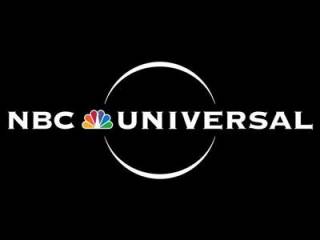

Production Costs
- Below-the-line costs: include technical or hardware costs of production 40% of budget. These costs in addition to hardware include everything from design, production equipment, and transportation for the staff.
- Above-the-line costs: software costs including creative talent 60% of budget. These costs cover the salaries of directors, producers, writers, as well as the actors themselves.
- Deficit financing: In television, the process whereby a TV production company leases its programs to a network for a license fee that is actually less than the cost of production; the company hopes to recoup this loss later in rerun syndication. Film studios like Disney, Sony, and Twentieth Century Fox finance the deficit. [2]
- TV builds up as larger deficit than cable which has shorter seasons.
- Television shows that have been the most expensive to produce include: Friends, Rome, Game of Thrones, and Deadwood
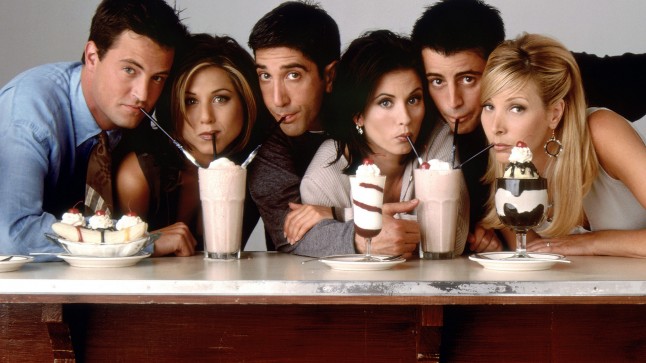
Rome: Despite its brief two season run, the drama: Rome remains to this day one of the most expensive show to produce to this day. With the costs of detailed set designs, well made roman clothing, and CGI each episode cost nearly 9 million dollars to make. [24]

Game of Thrones: Based on the novel series A Song of Ice and Fire by George R. R. Martin, this series currently costs an average of 6 million dollars per episode. These costs include traveling to locations to shoot, wardrobe, CGI for mythical creatures, and the paying the enormous cast. With the first season costing a grand total of nearly 60 millions dollars, it is likely the costs of this ongoing series will only continue to increase. [24] [26]

Deadwood: This three season long Western composed of 12 episodes per season cost 4.5 million dollars per episode to bring the West to our television screens. [24]

Production Process
 [27]
[27]
As you can see the production process is a multiple-step work flow including many different professionals: writers, artists for story boarding, actors, camera operators, directors, producers, marketers, packagers, etc. A lot goes into the production of TV content.
Distribution Model
The distributors of major United States television content are the companies that are part of large media conglomerates. These distributors distribute television content to us the consumer. Basically these are comprised of the major broadcasting networks. These distributors included NBCUniversal, CBS, ABC, and more. [28] [29] [30]
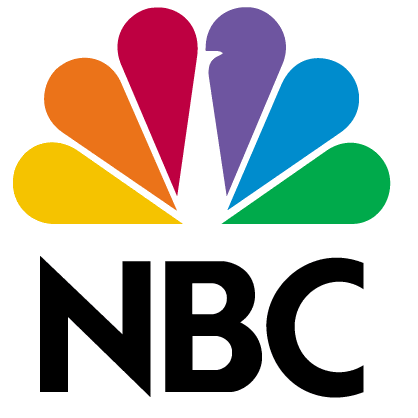


Background: How are programs paid for distribution?
- Subscription Fees: these fees account for distributing content to channels
- Retransmission fees: the fee that cable providers pay to broadcast networks for the right to carry their channels.
- O & Os: TV stations “owned and operated” by networks
- One owner is permitted to reach up to 39% of the nation’s 120 million plus TV households.
- 1940s Clearance Rules: Established by the FCC and Justice Department, all local affiliates are ultimately responsible for the content of their channels and must clear, or approve, all network’s programming. [2]
Major Cable and DBS Companies
- Multiple-system operators (MSOs): large corporations that own numerous cable companies and DBC providers.
- Multichannel video programming distributors (MVPDs): The cable industry’s name for its largest revenue generators, including cable companies and DBS providers. Cable and DBS distributors include Comcast, DirecTV, Dish Network, Time Warner Cable and more. [2]
When were there moments of substantial growth and decline? How did it handle the emergence of other media (competition)?
TV Sets Overtake Radio Receiver Sales (Growth)
- 1951: TV set sales surpasses radio receiver sales.
- 1953: More than 50% of America’s households have a TV.
- 1960: More than 90% of all homes have TV. [2]
Government Regulations Temporarily Restrict Network Control (Decline/Competition)
- April 1970 - Prime Time Access Rule (PTAR): an FCC regulation that reduced networks’ control of prime-time programming to encourage more local news and public-affairs programs, often between 6 and 7PM. However, stations simply ran 30 minutes of local news then acquired syndicated quiz shows.
- 1970 - Fin-syn (Financial Interest and Syndication Rules): FCC rules that prohibited the major networks from running their own syndication companies or from charging production companies additional fees after shows had completed their prime-time runs; most fin-syn rules were rescinded in the mid-1990s.
- 1975: Reacting to legal claims against monopolistic practices, the Justice department limited the networks’ production of non-news shows, requiring them to seek most of their programming from independent production companies and film studios.
- 1990s: FCC gradually phased out the ban limiting network production because the TV market grew more competitive. This opened the door for mega deals that have constrained independent producers from creating new shows and competing in prime time. [2]
End of the Network Era (Decline/Competition)
Network Era: the period from the late 1950s, when the networks gained control over content, to the end of the 1970s. During this time the Big Three broadcast networks – CBS, NBC, and ABC – dictated virtually every trend in programming and collectively accounted for more than 95% of all prime-time TV viewing. In contrast to 2012 when this figure was less than 40% due to cable, VCRs, and DVD players. [2]
The Rise of Cable TV (Growth)
Cable Threatens Broadcasting
- 1977: 14% of all US homes receive cable.
- 1985: 46% of all US homes receive cable.
- 1997: basic cable channels capture larger prime-time audience then broadcast networks.
- Narrowcasting: the providing of specialized programming for diverse and fragmented groups. Any specialized electronic programming or media channel aimed at a target audience.
- 1999: Cable penetration hit 70%
- Cable offers public greater opportunities to participate more fully in the democratic promise of television.
- 2012: Cable penetration dropped to 44% because of satellite TV. [2]
Consolidation (Growth)
- 1990s: FCC gradually phased out the ban limiting network production because the TV market grew more competitive. This opened the door for mega deals that have constrained independent producers from creating new shows and competing in prime time.
- Telecommunications Act of 1996: the sweeping update of telecommunications law that led to a wave of media consolidation. Brought cable under the federal rules that had long governed the telephone, radio, and TV industry; Knocked down barriers allowing regional phone companies, long-distance carriers, and cable companies to enter one another’s markets.
- Once deregulation began, many players in TV and cable consolidated which produced an oligopoly. [2]
The Major Broadcasting Networks
- 1985: GE buys back NBC
- 1990s: major networks begin acquiring and developing cable channels.
- 1995: Disney bought ABC
- 1999: Viacom buys CBS
- 2005: Viacom splits from CBS, but Viacom CEO remains CBS’s main stockholder
- 2011: Comcast purchases NBC Universal from GE [2]
Visual of Consolidation as of 2008 [31]:
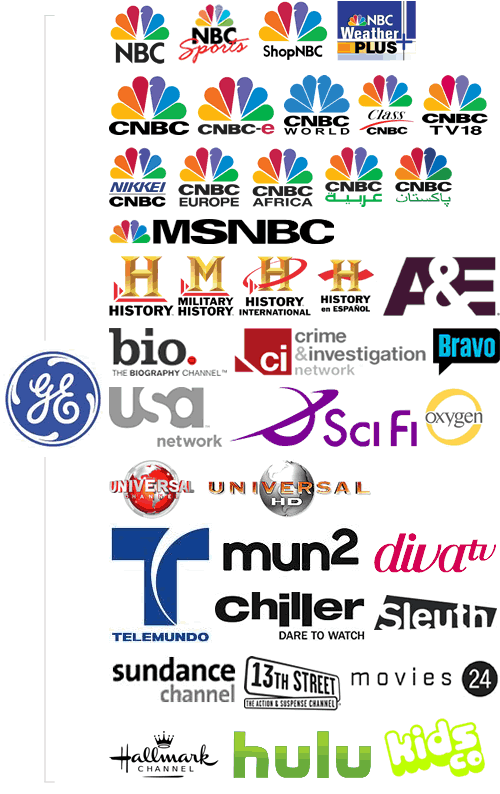

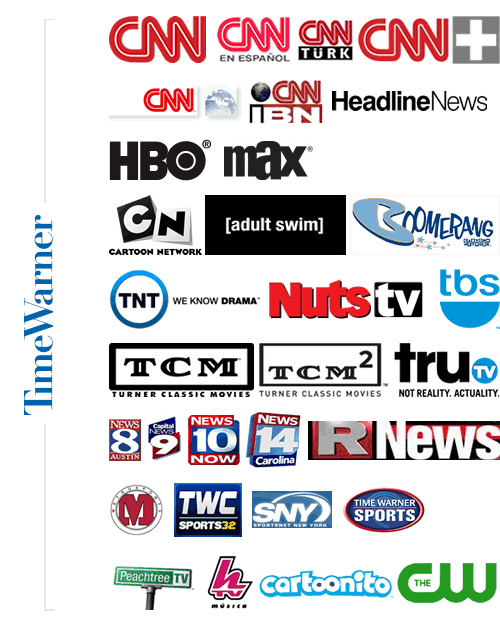
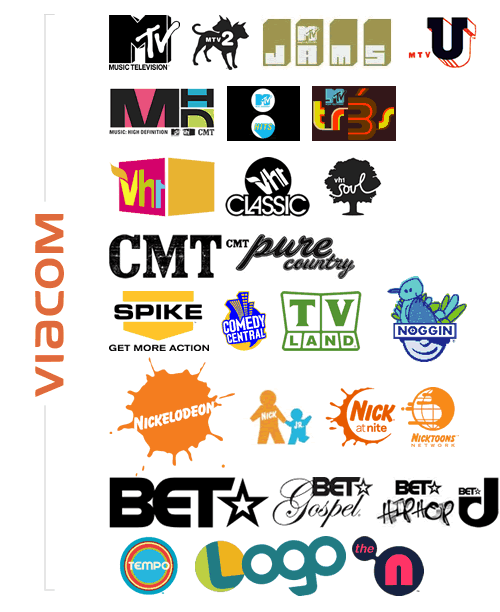


Rise of Satellite Hurts Cable (Growth/Competition/Decline)
- 1999 - Cable penetration dropped to 44% because of satellite TV
How did the internet impact the TV Industry?
Internet TV: Internet television is the process by which television shows can be streamed to electronic devices connected to the internet. This was put into place for customer convenience, as the viewer will no longer have to tape their television show in order to see it. Now it can be viewed anytime over internet streaming sources such as Netflix, Hulu, and more.
File Sharing: Record TV shows to watch at any time
Networks Have Websites and Offer Exclusive Online Content: Discounts and special offers if people check out the web page to receive coupons and deals
Social Media: Ads are embedded in every commercial of almost any product (i.e. McDonalds, Dicks Sporting Goods, Target) Social media also assists in advertising for television shows. Information about upcoming episodes, interviews, as well as show times can all be viewed from the show's facebook page. If said page is liked and followed, you will receive updates on your facebook wall on the regular to keep fans informed and anticipated for the next episode's release.
TV Converges with the Internet, Smartphones, and Mobile Media
- Third Screens: the computer-type screens on which consumers can view television, movies, music, newspapers, and books.
- Catch-up services: Hulu, Netflix, etc. allow users to “catch-up” on movies and programs that played earlier in theaters or on television.
- 2008: Netflix starts streaming videos.
- 2010: Hulu starts Hulu Plus, a paid subscription service.
- 2011: Cablevision, Time Warner, and DISH Network release iPad apps allowing their subscribers to watch live TV on their iPads at no additional charge.
- 2012: Hulu Plus has more than 2 million subscribers. Netflix has 26 million subscribers. Comcast has 23 million subscribers.
- TV giants have streaming through TV Everywhere, Xfinity TV, and HBO GO.
- Fourth-Screen: Technologies like smartphones, iPods, iPads, and mobile TV devices that are forcing major changes in consumer viewing habits and media content creation.
- Multifunctionality and portability of third and fourth screen devices means that consumers may no longer need television sets. [2]
Television Home Television Present Television Future
Sources:
http://youtu.be/HHy04aN0jfI
Campbell, Richard, Christopher R. Martin and Bettina Fabos. Media & Culture. Boston: Bedford/St. Martin's, 2014.
"Vladimir Zworykin." - GHN: IEEE Global History Network. N.p., n.d. Web. 02 Feb. 2014. <http://www.ieeeghn.org/wiki/index.php/Vladimir_Zworykin>.
Campbell, Richard, Christopher R. Martin, and Bettina Fabos. "Chapter 6: Television and Cable- Technology and Convergence Change Viewing Habits." Media & Culture: Mass Communication in a Digital Age. Ninth ed. Boston, New York: Bedford/St. Martin, 2013. Print.
http://upload.wikimedia.org/wikipedia/commons/thumb/9/98/Zvorykin0.jpg/250px-Zvorykin0.jpg
http://1.bp.blogspot.com/-ustMrpfq8Fg/T4WsGDtJlbI/AAAAAAAAALk/ztIJTHBZayA/s1600/Region+1+Logo+Wire+++NTSC-01.jpg
http://blogs.citypaper.com/wp-content/uploads/2013/08/comcast-logo.jpg
http://www.zainimedia.com/social/whats-cost-video-production/
http://blog.mipworld.com/2012/02/infographic-exploring-the-future-of-tv/capture-d%E2%80%99ecran-2012-02-13-a-16-54-03/
http://www.neatorama.com/2008/07/07/who-owns-what-on-television/#!BzGWj
http://www.leaderpost.com/technology/beginner+guide+smart/9264402/story.html
http://en.wikipedia.org/wiki/Internet_TV
http://inventors.about.com/library/inventors/blfarnsworth.htm
http://upload.wikimedia.org/wikipedia/en/1/1c/Current_DIRECTV_Logo.gif
http://thedesk.matthewkeys.net/wp-content/uploads/2013/09/dish-network-logo-5161083.jpg
http://www.voxlumiere.com/wp-content/uploads/2009/10/vcr.jpg
http://www.samsung.com/us/2012-smart-tv/img/intro-smartHubTV.png
http://img.talkandroid.com/uploads/2013/10/att_logo_large.jpg
http://www.digitallanding.com/wp-content/uploads/2012/09/xfinity-on-demand-inside.jpg
http://www.therichest.com/expensive-lifestyle/entertainment/the-top-10-most-expensive-tv-series-ever-made/
http://upload.wikimedia.org/wikipedia/fr/4/46/TCFTV.jpg
http://www.gabelliconnect.com/wp-content/uploads/2012/08/51921.6a00d83451b05569e20120a704abde970b-pi.jpg
http://falkvinge.net/files/2013/01/84679-friends-friends-646x363.jpg
http://winteriscoming.net/wp-content/uploads/2011/06/Game_of_Thrones_title_card.jpg
http://www.engadget.com/2005/09/19/blu-ray-vs-hd-dvd-state-of-the-s-union-s-division/
http://en.wikipedia.org/wiki/Big_Three_television_networks
http://en.wikipedia.org/wiki/History_of_television
http://www.kenstone.net/fcp_homepage/faking_it.html
http://timesfm.co.tz/blog/2013/10/30/2468-kenya-yaahirisha-kuhamia-digitali-dec-2013,-sasa-ni-june-mwakani
http://www.medialit.org/reading-room/societys-storyteller-how-tv-creates-myths-which-we-live
http://inventors.about.com/library/inventors/blcabletelevision.htm
http://screencrave.com/2011-09-27/eight-ways-television-has-changed-from-the-30s-to-today/
http://tvtropes.org/pmwiki/pmwiki.php/Main/Syndication
http://www.nytimes.com/2011/01/28/business/media/28adco.html?_r=1&
http://supreme.justia.com/cases/federal/us/440/689/case.html
http://www.myaccount.charter.com/customers/support.aspx?supportarticleid=23
http://transition.fcc.gov/telecom.html
http://deafness.about.com/cs/featurearticles/a/historycaptions.htm
http://mroche.umwblogs.org/impact-of-the-vhs/
http://www.liketotally80s.com/vhs-vs-betamax.html
http://www.emmytvlegends.org/resources/tv-history
http://inventors.about.com/od/xzstartinventors/a/Zworykin.htm
http://en.wikipedia.org/wiki/Internet_television
http://www.zainimedia.com/social/whats-cost-video-production/
http://www.fcc.gov/encyclopedia/evolution-cable-television
http://www.neatorama.com/2008/07/07/who-owns-what-on-television/#!zRAtc
Footnotes:
1. http://en.wikipedia.org/wiki/Big_Three_television_networks
2. Campbell, Richard, Christopher R. Martin, and Bettina Fabos. "Chapter 6: Television and Cable- Technology and Convergence Change Viewing Habits." Media & Culture: Mass Communication in a Digital Age. Ninth ed. Boston, New York: Bedford/St. Martin, 2013. Print.
3. http://www.ieeeghn.org/wiki/index.php/Vladimir_Zworykin
4. http://upload.wikimedia.org/wikipedia/commons/thumb/9/98/Zvorykin0.jpg/250px-Zvorykin0.jpg
5. https://www.youtube.com/watch?v=HHy04aN0jfI&feature=youtu.be
6. http://www.earlytelevision.org/images/Utilicon.jpg
7. http://www.spacealliance.ro/articles/images/a/20100225_3.JPG
8. http://1.bp.blogspot.com/-ustMrpfq8Fg/T4WsGDtJlbI/AAAAAAAAALk/ztIJTHBZayA/s1600/Region+1+Logo+Wire+++NTSC-01.jpg
9. http://www.wired.com/images_blogs/business/2009/06/fcc-logosvg1.png
10. http://blogs.citypaper.com/wp-content/uploads/2013/08/comcast-logo.jpg
11. http://img.talkandroid.com/uploads/2013/10/att_logo_large.jpg
12. http://www.digitallanding.com/wp-content/uploads/2012/09/xfinity-on-demand-inside.jpg
13. http://thedesk.matthewkeys.net/wp-content/uploads/2013/09/dish-network-logo-5161083.jpg
14 http://upload.wikimedia.org/wikipedia/en/1/1c/Current_DIRECTV_Logo.gif
15. http://www.voxlumiere.com/wp-content/uploads/2009/10/vcr.jpg
16. http://blog.mipworld.com/2012/02/infographic-exploring-the-future-of-tv/mipcubegraphic-1/
17. http://www.leaderpost.com/technology/beginner+guide+smart/9264402/story.html
18. http://www.samsung.com/us/2012-smart-tv/img/intro-smartHubTV.png
19. https://lh6.ggpht.com/As1QSBElyvhvsFGomR8yKWD1SRprTbP1cAHcVnLa4n-luZfcipOscIQ1BbaOndViPMB1mA=s113
20. https://www.youtube.com/watch?v=pKM4MNrB25o
21. http://upload.wikimedia.org/wikipedia/fr/4/46/TCFTV.jpg
22. http://www.gabelliconnect.com/wp-content/uploads/2012/08/51921.6a00d83451b05569e20120a704abde970b-pi.jpg
23. http://upload.wikimedia.org/wikipedia/en/thumb/0/02/Warner_Bros_Television.jpg/800px-Warner_Bros_Television.jpg
24. http://www.therichest.com/expensive-lifestyle/entertainment/the-top-10-most-expensive-tv-series-ever-made/
25. http://falkvinge.net/files/2013/01/84679-friends-friends-646x363.jpg
26 http://winteriscoming.net/wp-content/uploads/2011/06/Game_of_Thrones_title_card.jpg
27. http://www.zainimedia.com/social/whats-cost-video-production/
28. http://upload.wikimedia.org/wikipedia/commons/8/8f/LogoNBC.png
29. http://astrostyle.com/wp-content/uploads/2013/03/cbs-logo.png
30. http://www.mediabistro.com/tvspy/files/2013/05/ABC-LOGO.jpg
31. http://www.neatorama.com/2008/07/07/who-owns-what-on-television/#!zRAtc
Comments (4)
Yia Yang said
at 9:22 am on Mar 25, 2014
we could also make a home, present, future links in the bottom of the page so we dont have to scroll up
Nick Siever said
at 9:38 pm on Mar 26, 2014
NEVER! WE MUST ALWAYS SCROLL UP! Haha. Just kidding. I'll get to it when I have time.
Yia Yang said
at 12:29 pm on Mar 25, 2014
the past could use more images and videos
Nick Siever said
at 9:38 pm on Mar 26, 2014
nah I think we have plenty of images now.
You don't have permission to comment on this page.